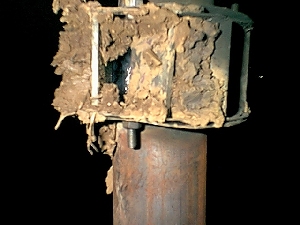
This shows the mostly full drum of cotton stalks. This trial did not work so we moved on to a denser fuel, bamboo.
Having come all the way to India to present a paper on this topic (Preliminary
Tests on Charcoal Making-
Pyrolysis Gas Burners)
it seemed appropriate to at least try and demonstrate the concept. So after
the conference I spent two quick days in Phaltan, building, modifying and
trying out a oil drum charcoal maker modeled after one I built back
in Canada three years ago.

This shows the mostly full drum of cotton stalks. This trial did not
work so we moved on to a denser fuel, bamboo.

Here the drum full of vertically packed bamboo is ignited on top.
The drum has a few dozen small holes in the bottom for
primary air to promote the partial combustion, or pyrolysis of the
bamboo. During startup no air is allowed into the drum from
below. The fire on top needs to be burning over the whole surface.
Then a small hole is dug in the dirt at the bottom of the drum to allow
some air up through the bamboo to the fire on top. This increases the fire
intensity and causes the fire to move down into the bamboo below the top.
After five or ten minutes the burner can be placed on top.

With the burner placed on top the flames are extinguished and the bamboo smoulders or pyrolyses. Notice the small opening in the dirt at the bottom of the drum.

The smoke or gasses from the pyrolysing bamboo rises up through the pipe, and mixes with air drawn in through l secondary air slots. Flame is introduced through these slots to ignite the mixture which burns in the wider chimney above.

Hear the ARTI staff are standing beside the charcoal maker while it is operating. A noisey flame is burning in the chimney and there are no visible emissions. Well at least for that moment. Variations in the rate of pyrolysis will cause a change in the gas-air mix entering the chimney burner. Occasionally the flame goes out and the chimney is full of dense smoke. After adjusting primary and secondary air supply the burner can be relit. This small poof tended to send a well formed smoke ring high into the sky and floating off over the feilds.

In this case we used mud to block the secondary air inlet holes that
weren't needed. After a while the burner functioned with only one of the
eight secondary air slots blocked with mud. The rate of pyrolysis in the
drum is governed by the fuels type, size, moisture content and flow of
air. The flow of air is governed by an opening at the bottom of the drum
and the chimeny effect of the rising gasses through the pipe on top. The
diameter and lenght of this pipe are the key variables for the smooth performance
of this process. So the second day was spent replacing the
first design with a larger pipe. This resulted in more stable
combustion. We never did see the cycle from start to finnish. The night
fall forced us to leave the glowing chimney and return to Phaltan.
So after two days with some success I had to leave
Hemant Mahajan to continue experiments with the rest of the crew at
ARTI.